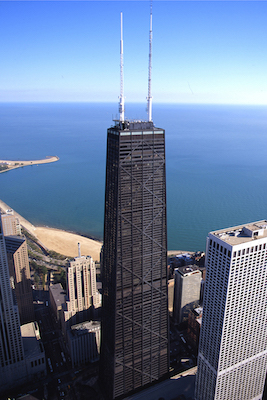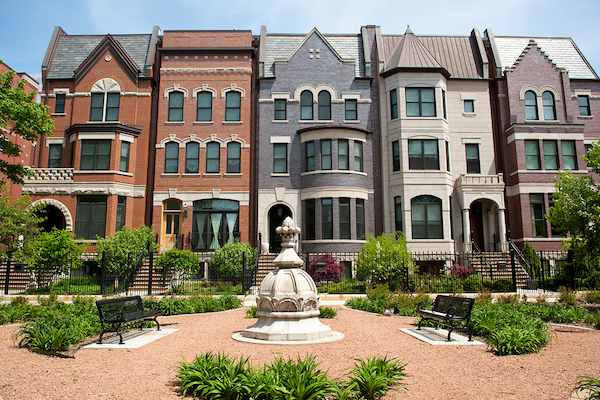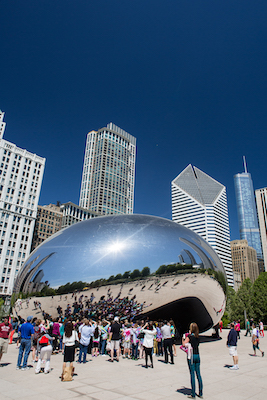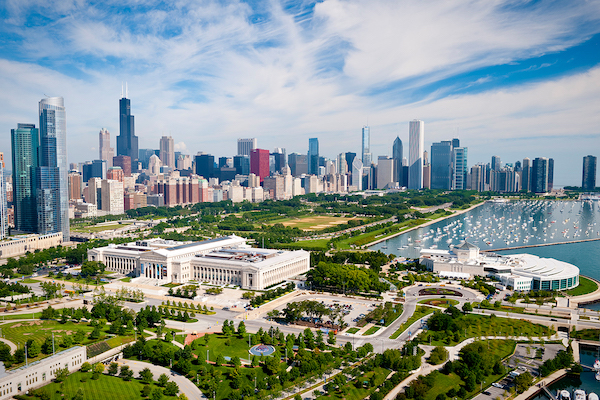By Lisa Schuetz | Photos courtesy Choose Chicago
There’s no doubt that Chicago fascinates those of us who live in its little cousin to the north. We head there for stellar shopping, magical shows and exciting nights on the town. Then there’s the draw of its architecture and design. In fact, some would arguably call Chicago the epicenter of architectural innovation, not to mention interior design. And much of it is available to tour.
Quite simply, the city has attracted some of the most innovative schools of architectural thought and many of the world’s most respected architects have designed buildings there. It was so well known as an innovative center, it was home to the World’s Columbian Exposition in 1893 celebrating the 400th anniversary of Columbus landing in the Americas. Its exhibits included multiple buildings by top architects. Although most of the buildings are gone, some, like the Palace of Fine Arts, now the Museum of Science and Industry, still stand.
At around the same time, the city’s design style of using steel-frames clad with masonry was known worldwide as the “Chicago School,” and included work by Henry Hobson Richardson, Dankmar Adler, Louis Sullivan, John Root and Daniel Burnham. The Rookery at 209 S. LaSalle St. and the Monadnock Building at 53 W. Jackson Blvd., both designed by the firm Burnham and Root, exemplify the early Chicago School.
The second Chicago School describes the modern architectural movement that started around the 1940s led by Ludwig Mies van der Rohe, who is known for saying “less is more.” His building at 860-880 Lake Shore Dr. is a strong example. Fazlur Khan and the illustrious firm Skidmore, Owings and Merrill contributed further after 1960. They collaborated to build the John Hancock Center, now called 875 North Michigan Avenue, which at the time was the second tallest building in the world, at 100 stories. Of course, for 25 years after it was built in 1973, the Sears Tower, now the Willis Tower, also designed by Khan, was the world’s tallest at 110 stories.
Chicago is also known for its competitions. In 1922, the Chicago Tribune held a competition to build its namesake tower at 435 N. Michigan Ave. There were 260 entries, including such luminaries as Eliel Saarinen, Adolf Loos and Walter Gropius, founder of the Bauhaus school. The winners were John Mead Howells and Raymond Hood with their neo-Gothic design.
And soon, Chicago’s O’Hare International Airport will be improved by one of five contest entrants that include some of the world’s most well-known architects, including Spaniard Santiago Calatrava (who designed the Milwaukee Art Museum) and Chicago’s Jeanne Gang, who designed the curvaceous Aqua Towers, built in 2009 at 225 N. Columbus Dr. Even the public got to cast a vote for their favorite of the five entries.
Chicago’s architecture has more going for it than skyscrapers and commercial buildings. Its residential architecture is also significant. Four predominant styles can be seen everywhere. More than 100,000 bungalows were built in the mid- 20th century. Then there’s the Chicago Graystone built with Indiana limestone as both multi-family homes or single-family townhouses; the framed two-flat that typically housed the owner on the first floor and a renter on the second; and the court- yard building, usually a three-story apartment building with six units built around a small greenspace in the early 1900s.
So, what’s the best method for seeing the architecture of the city? The Chicago Architecture Center at 111 E. Wacker Dr., (architecture.org), is a nonprofit dedicated to creating tours, exhibitions and programs revolving around architecture. They have more than 85 tours available by bus, bike, foot and boat. You can also see how the wealthy lived in the 19th century by visiting the Glessner House Museum (glessnerhouse.org) at 1800 S. Prairie Ave., designed by Henry Hobson Richardson.
SLEEP
Chicago has several hotels in historic buildings:
THE PALMER HOUSE HILTON is in Chicago’s Loop. Burned in the Great Chicago Fire of 1871 just 13 days after it opened, it was reopened in 1873. The epitome of glamour, it includes a spa and two restaurants.
THE DRAKE HOTEL was built in 1920 and is considered society’s choice with royalty and presidents having stayed there. It offers afternoon tea and several restaurants at the top of the Magnificent Mile.
THE ALISE HOTEL was built in 1895 and designed by Daniel Burnham, John Root and Charles Atwood. It includes the restaurant Atwood and is on the National Register of Historic Places.
EAT
When it comes to food, you may want to try one of the innovators:
BAR SÓTANO is the latest Latino food and drink venture by Rick Bayless.
ELSKE offers award-winning Danish fare in indoor and outdoor dining spaces.
VIRTUE in trendy Hyde Park serves upscale soul food.
To view more Midwest destinations, read our City Sojourns.









Comments are closed.